Waste Management and the Circular Economy in Cyprus—The Case of the SWAN Project
Abstract
:1. Introduction
2. Waste Management and the Circular Economy in Cyprus: Current Status
2.1. Waste Management in Cyprus
- 50% separate collection on total MSW and 15% separate collection of the organic waste in MSW by 2021;
- 50% recycling of paper, plastic, metal, and glass by 2021;
- Reduce landfilling to a maximum of 20% of MSW by 2021 and 10% by 2035;
- Increase recycling and reuse of municipal waste to 55% by 2025, 60% by 2030 and to 65% by 2035.
2.2. Circular Economy in Cyprus
2.3. The SWAN Project
- WP1—project management and coordination, which set the basic management principles of the project.
- WP2—project communication and dissemination, which developed a communication plan, aiming at the promotion of the project and the dissemination of its activities and results.
- WP3—development of a digital solid-waste reuse platform, which built a digital platform, acting as the basis for the establishment of solid-waste reuse value chains.
- WP4—sink and source mapping, which developed the SWAN map of solid-waste sources and potential receivers in the Balkan region and Cyprus.
- WP5—sink and source mapping, which developed the algorithm that processes the SWAN solid-waste map and provided different alternatives for the solid-waste reuse chains and related business models.
- WP6—integration and synthesis, which ensured the management of knowledge and the synthesis of the results and led to the establishment of an industrial ecosystem.
3. Methodology
4. Analysis of the Cypriot Data
- General characteristics of the industrial units, such as the name, type (NACE code) and location;
- Major solid-waste streams, including their type (as described by the European waste classification type or the EWC-Stat type), the available quantity and seasonal variations, and the current management method together with the relevant cost;
- Solid input streams that can be considered for waste reuse, including their type, the required quantity and seasonal variations, and the current supply method together with the current supply cost; and
- Supplementary questions, describing the knowledge around the concepts of industrial symbiosis and willingness to participate in symbiotic schemes and the SWAN industrial ecosystem.
4.1. Participants Profile
4.2. Industrial Views on Industrial Symbiosis
- Q1. Are you familiar with the concept of the circular economy, and if yes, what do you consider to be its main benefits?
- Q2. Are you familiar with the concept of industrial symbiosis?
- Q3. Are there any existing symbiotic links in the company?
- Q4. Would the unit be interested in participating in symbiotic value chains?
4.3. Proposed Business Models
4.4. Based on the Type of Source Industry
4.4.1. Wineries
4.4.2. Meat and Poultry Industry
4.4.3. Dairy Industry
4.4.4. Grain Mill Industry
5. Discussion
- The awareness of the responders about the circular economy (CE) is very high but becomes lower as we move into more specialized topics such as industrial symbiosis (IS). However, less than half of the respondents (49%) answered that industrial symbiosis links are available in their organisations.
- The interest of the respondents in participating in the SWAN or a similar project is very high.
- Most of the industries that responded were small firms (~62.5%), followed by SMEs (~27%). Moreover, most of the industries were quarries (~21.5%), followed by waste treatment and disposal facilities (~8.5%).
- The main waste output streams were plastic, followed by paper/cardboard and glass, while the main input streams were solid mineral materials, followed by composites and organic material.
- Based on both the collected data and the best practices available, the potential waste reuse business models are (i) sludge exchange between wineries as well as other industrial units and cement, bricks, and tile factories and (ii) paper and cardboard packaging between grain mills and wood, wood products, and cork manufactures.
Author Contributions
Funding
Data Availability Statement
Conflicts of Interest
References
- United Nations, Environmental Glossary. Available online: https://unstats.un.org/unsd/environmentgl/ (accessed on 13 January 2022).
- Chatzipanagiotou, K. Waste Management; Technical Chamber of Cyprus: Nicosia, Cyprus, 2019. [Google Scholar]
- The World Bank. What a Waste: A Global Review of Solid Waste Management; Urban Development & Local Government Unit, World Bank: Columbia, WA, USA, 2012. [Google Scholar]
- United Nations, New Urban Agenda. 2017. Available online: https://unhabitat.org/sites/default/files/2019/05/nua-english.pdf (accessed on 10 October 2021).
- United Nations. Transforming Our World: The 2030 Agenda for Sustainable Development; United Nations: New York, NY, USA, 2015. [Google Scholar]
- Geissdoerfer, M.; Vladimirova, D.; Evans, S. Sustainable business model innovation: A review. J Clean. Prod. 2018, 198, 401–416. [Google Scholar] [CrossRef]
- Oghazi, P.; Mostaghel, R. Circular Business Model Challenges and Lessons Learned—An Industrial Perspective. Sustainability 2018, 10, 739. [Google Scholar] [CrossRef] [Green Version]
- Lüdeke-Freund, F. Towards a Conceptual Framework of Business Models for Sustainability. In Proceedings of the Knowledge Collaboration & Learning for Sustainable Innovation ERSCP-EMSU Conference, Delft, The Netherlands, 25–29 October 2010. [Google Scholar]
- Bakas, I. Municipal Waste Management in Cyprus; ETC/SCP Working Paper; EEA: Copenhagen, Denmark, 2013. [Google Scholar]
- Eurostat—Generation of Waste by Waste Category, Hazardousness and NACE Rev. 2 Activity. Available online: http://appsso.eurostat.ec.europa.eu/nui/show.do?dataset=env_wasgen&lang=en (accessed on 20 October 2021).
- Zorpas, A. Setting the Proposed Priorities and Goals at a National Level; Dept of Environment, Ministry of Agriculture, National Resources and Environment: Strovolos, Cyprus, 2013.
- Eurostat Treatment of Waste by Waste Category, Hazardousness and Waste Management Operations. Available online: http://appsso.eurostat.ec.europa.eu/nui/show.do?lang=en&dataset=env_wastrt (accessed on 20 October 2021).
- Cyprus’ Municipal Solid Waste Per Inhabitant among Highest in EU. Available online: https://in-cyprus.philenews.com/cyprus-municipal-solid-waste-per-inhabitant-among-highest-in-eu/ (accessed on 10 December 2021).
- Castillo-Giménez, J.; Montañés, A.; Picazo-Tadeo, A.J. Performance in the treatment of municipal waste: Are European Union member states so different? Sci. Total Environ. 2019, 687, 1305–1314. [Google Scholar] [CrossRef] [PubMed]
- Confederation of European Waste-to-Energy Plants—Municipal Waste Treatment 2018. Available online: https://www.cewep.eu/municipal-waste-treatment-2018/ (accessed on 20 October 2021).
- Circular Economy—The Role of Cyprus and Potential Challenges. Available online: https://epihirimatiki.com/epikairotita/arthrografia/kykliki-ikonomia-o-rolos-tis-kyprou-ke-pithanes-proklisis/ (accessed on 20 October 2021).
- Cyprus, the Island Sinking in Waste. Available online: https://www.neweurope.eu/article/cyprus-the-island-sinking-in-waste/ (accessed on 20 October 2021).
- Marino, A.; Pariso, P. Comparing European countries' performances in the transition towards the Circular Economy. Sci. Total Environ. 2020, 729, 138142. [Google Scholar] [CrossRef] [PubMed]
- New Slap for Cyprus over Landfill Directive and Other Failings. Available online: https://cyprus-mail.com/2021/12/03/new-slap-for-cyprus-over-landfill-directive-and-other-failings/ (accessed on 1 December 2021).
- Cyprus Waste Factsheet. Available online: https://ec.europa.eu/environment/pdf/waste/framework/facsheets%20and%20roadmaps/Factsheet_Cyprus.pdf (accessed on 1 December 2021).
- European Commission: The Environmental Implementation Review 2019—Country Report Cyprus. Available online: https://ec.europa.eu/environment/eir/pdf/report_cy_en.pdf (accessed on 1 December 2021).
- Directorate-General for Environment. The EU Environmental Implementation Review 2019, Country Report—Cyprus; European Commission: Brussels, Belgium, 2019. [Google Scholar]
- Ranking How EU Countries do with the Circular Economy. Available online: https://www.politico.eu/article/ranking-how-eu-countries-do-with-the-circular-economy/ (accessed on 1 December 2021).
- Charalampous, A. Circular Economy: Challenges and Prospects; Cyprus University of Technology: Limassol, Cyprus, 2018. [Google Scholar]
- Seven Suggestions from Cyprus Employers and Industrialists Federation on Circular Economy for Businesses. Available online: https://www.brief.com.cy/analyseis/oi-epta-protaseis-tis-oeb-gia-kykliki-oikonomia-stis-epiheiriseis (accessed on 1 December 2021).
- Angelis-Dimakis, A.; Arampatzis, G.; Pieri, T.; Solomou, K.; Dedousis, P.; Apostolopoulos, G. SWAN platform: A web-based tool to support the development of industrial solid waste reuse business models. Waste Manag. Res. 2021, 39, 489–498. [Google Scholar] [CrossRef] [PubMed]
- Rockenbach, I.I.; Rodrigues, E.; Gonzaga, L.V.; Caliari, V.; Genovese, M.I.; Gonçalves, A.E.S.S. Phenolic compounds content and antioxidant activity in pomace from selected red grapes (Vitisvinifera L. and Vitislabrusca L.) widely produced in Brazil. Food Chem. 2011, 127, 174–179. [Google Scholar] [CrossRef]
- Bustos, G.; Calvar, S.; Vecino, X.; Cruz, J.M.; Moldes, A.B. Industrial symbiosis between the winery and environmental industry through the utilization of grape Marc for water desalination containing copper(II). Water Air Soil Pollut. 2018, 229, 36. [Google Scholar] [CrossRef]
- Mateo, J.J.; Maicas, S. Valorization of winery and oil mill wastes by microbial technologies. Food Res. Int. 2015, 73, 13–25. [Google Scholar] [CrossRef]
- Spekkink, W. Industrial Symbiosis as a Social Process: Developing Theory and Methods for the Longitudinal Investigation of Social Dynamics in the Emergence and Development of Industrial Symbiosis. Ph.D. Thesis, Erasmus University of Rotterdam, Rotterdam, The Netherlands, 2016. [Google Scholar]
- Burg, V.; Golzar, F.; Bowman, G.; Hellweg, S.; Roshandel, R. Symbiosis opportunities between food and energy system: The potential of manure-based biogas as heating source for greenhouse production. J. Ind. Ecol. 2020, 25, 648–662. [Google Scholar] [CrossRef]
- Yazan, D.M.; Fraccascia, L.; Mes, M.; Zijm, H. Cooperation in Manure-Based Biogas Production Networks: An Agent-Based Modeling Approach. Appl. Energy 2018, 212, 820–833. [Google Scholar] [CrossRef]
- Stasinakis, A.S.; Charalambous, P.; Vyrides, I. Dairy wastewater management in EU: Produced amounts, existing legislation, applied treatment processes and future challenges. J. Environ. Manag. 2022, 303, 114152. [Google Scholar] [CrossRef] [PubMed]
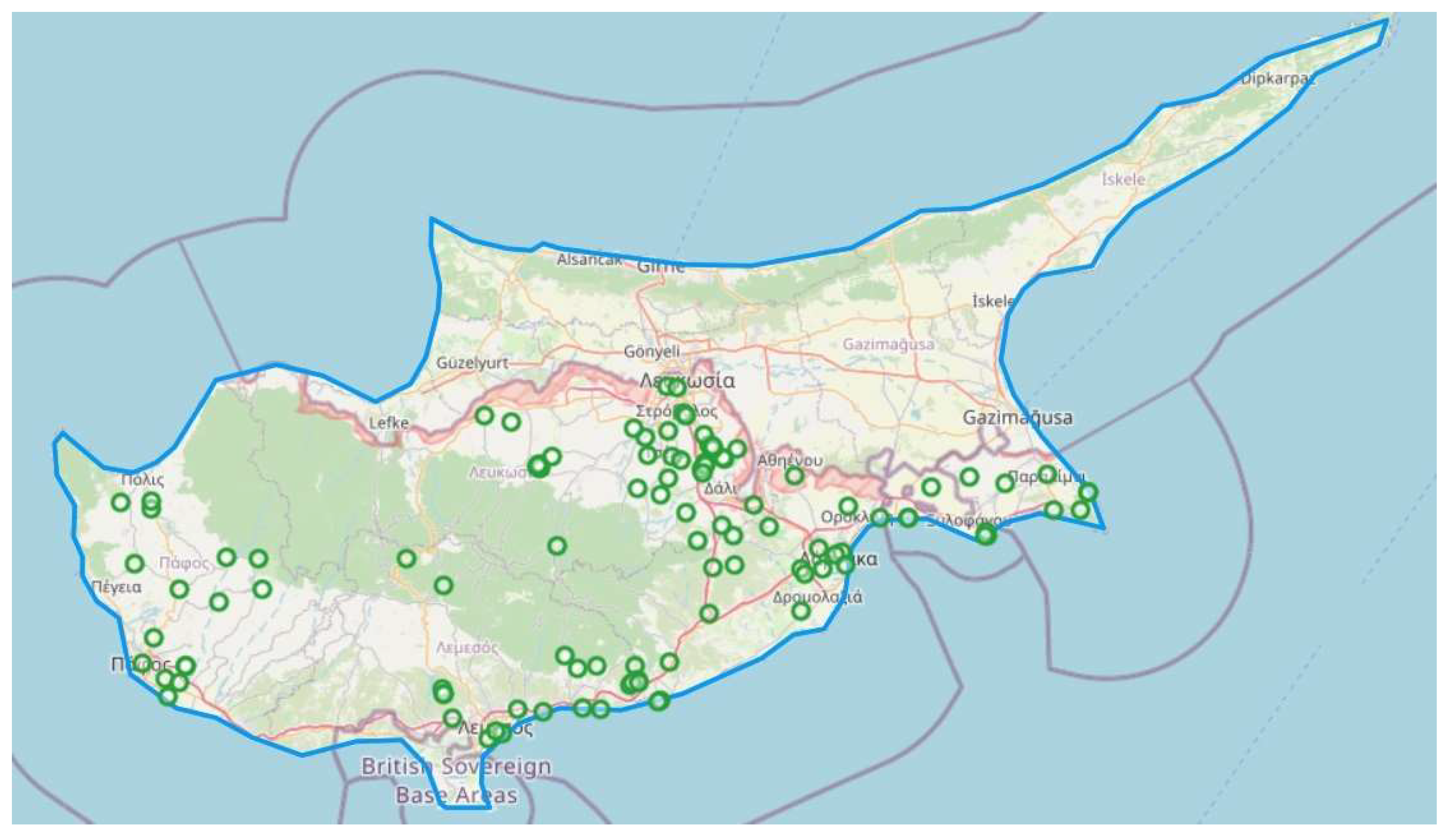
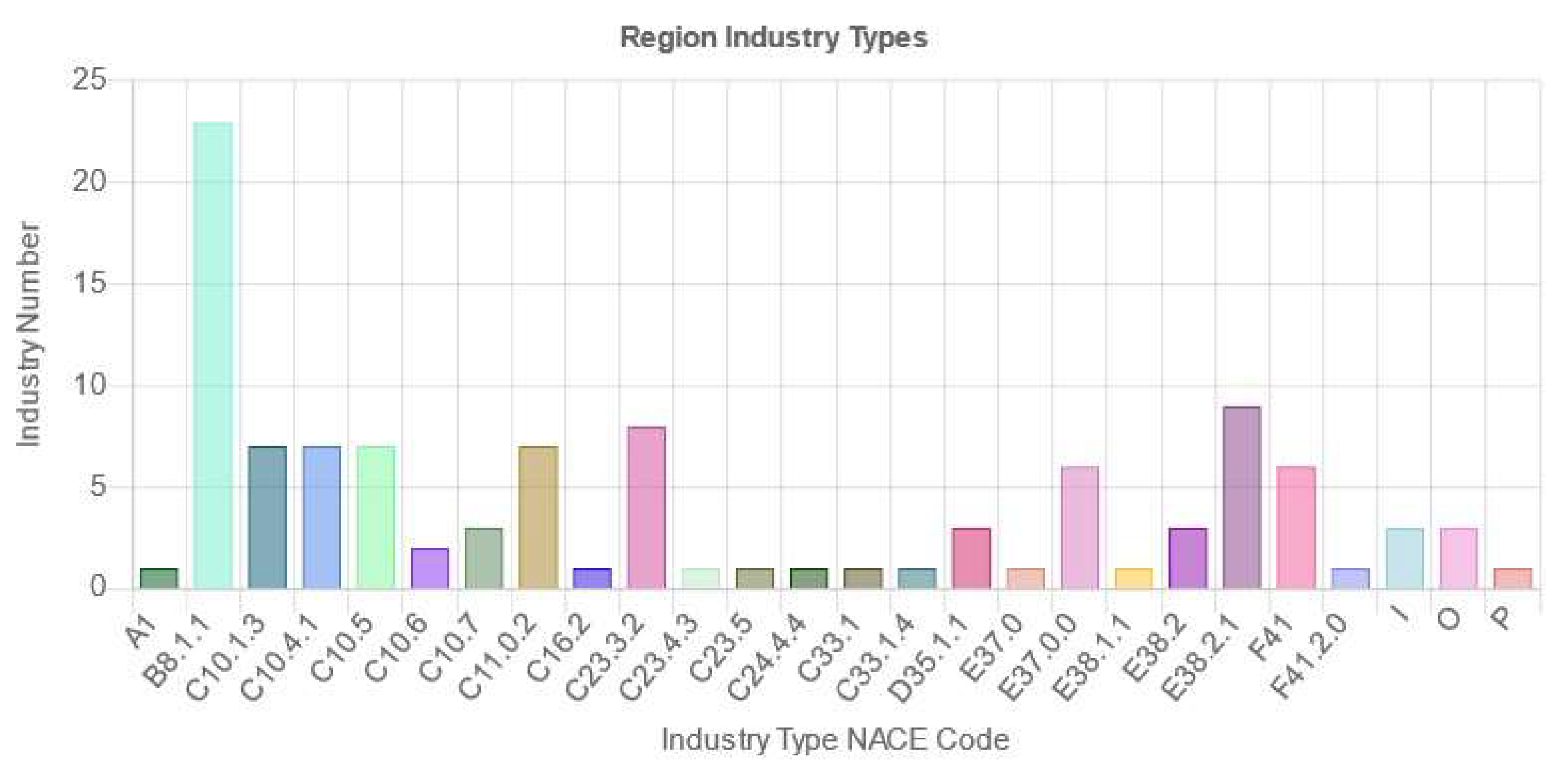
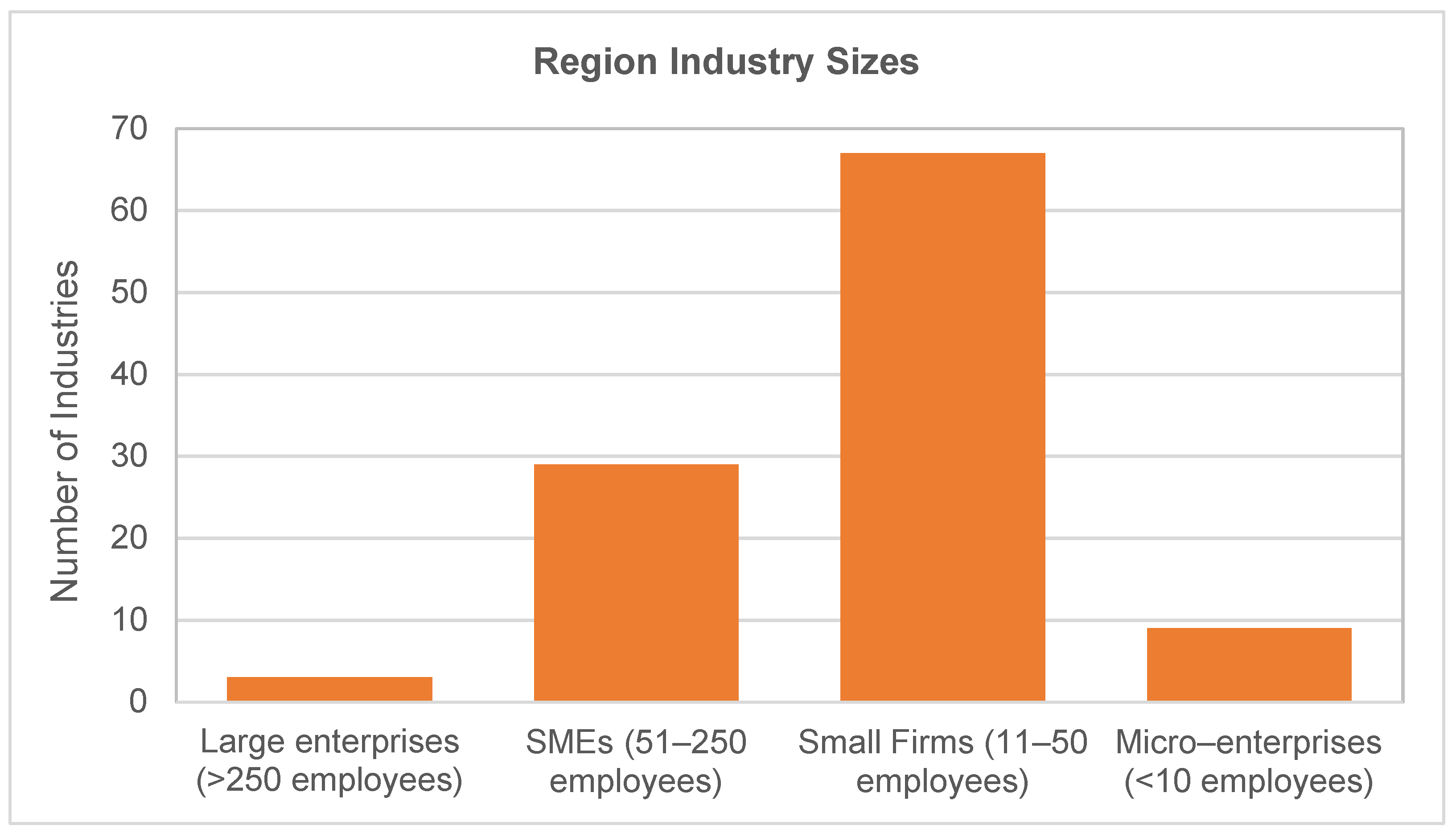
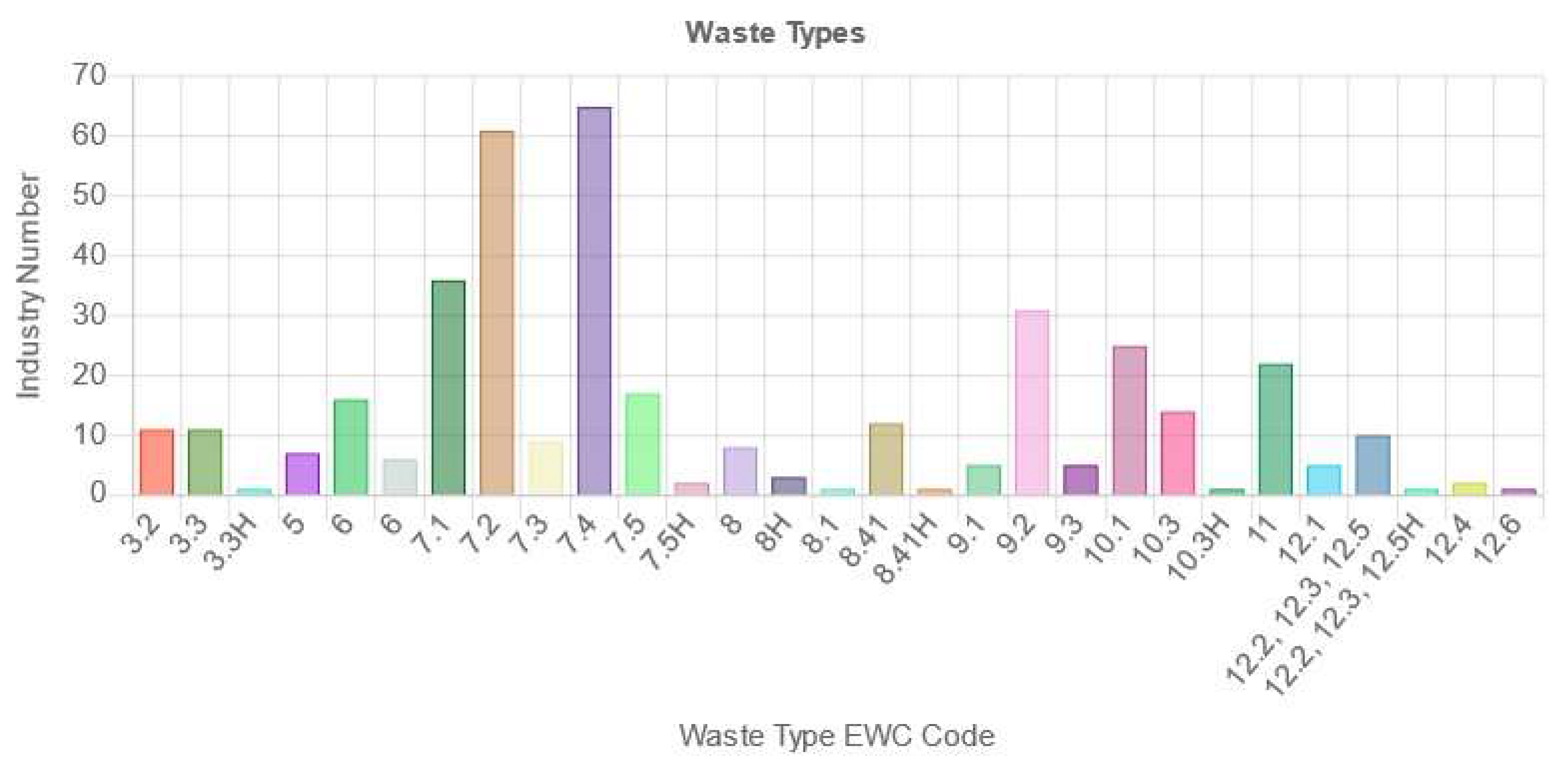
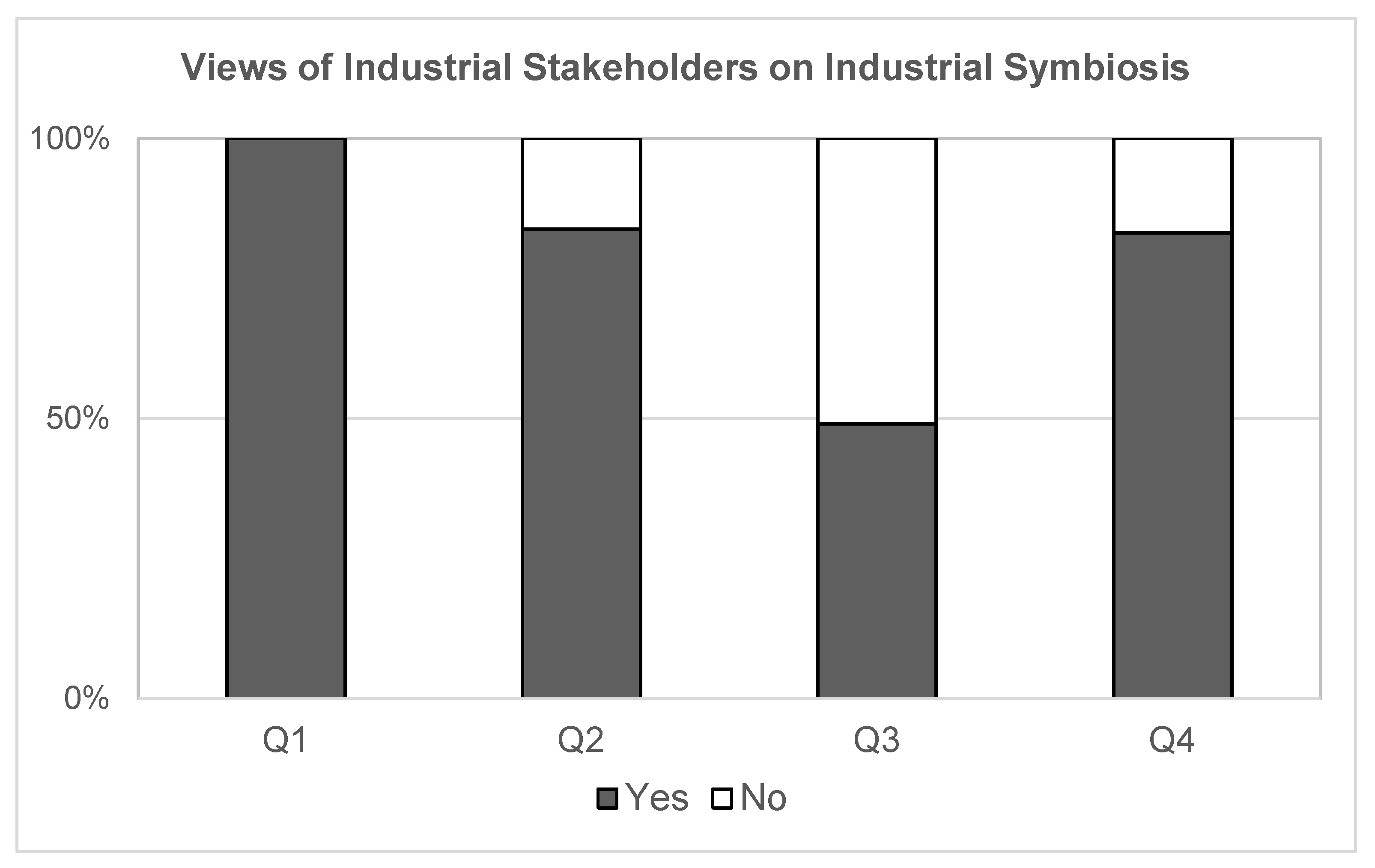
| Waste Type | Quantity |
|---|---|
| Crimps (waste from grape compression) | 27.8 |
| Filters | 0.4 |
| Glass packaging | 2.8 |
| Marbles (waste from grape compression) | 102.6 |
| Paper and cardboard packaging | 2.4 |
| Plastic packaging | 2.8 |
| Wine sludge (heavy) | 11.8 |
| Wine sludge (light) | 29.4 |
| Waste Type | Quantity |
|---|---|
| Animal manure | 5340 |
| Clinical waste | 5 |
| Dead chickens | 5 |
| Municipal waste (from personnel) | 14 |
| Paper and cardboard packaging | 12 |
| Plastic packaging | 12 |
| Expired products | 12 |
| Waste Type | Quantity |
|---|---|
| Paper and cardboard packaging | 73 |
| Flour dust | 30 |
| Flour products (expired) | 28 |
| Plastic packaging (HDPE) | 2 |
| Scrap metal | 18 |
| Waste Producers | Main Waste Produced | Potential Waste Receivers Type Based on the SWAN Best Practices Database | Potential Waste Receivers in the Case of Cyprus | Next Steps | Critical Points |
|---|---|---|---|---|---|
| Wineries (7 units) | Crimps | Pharmacological, cosmetics, and food industries | N/A 1 | Further research is required | Quantities produced/ required Producer- supplier distance and way of transport Collective waste gathering and transportation |
| Waste treatment plants | Four waste treatment plants | Examine the possibility of matching | |||
| Sludge | Manufacture of pulp paper and paperboard (C17.1) | N/A | Further research is required | ||
| Manufacture of brick, tiles and construction products (C23.3.2) | Eight industrial plants (C23.3.2) | Examine the possibility of matching | |||
| Manufacture of cement, lime and plaster (C23.5) | One manufacturing facility (C23.5) | Examine the possibility of matching | |||
| Fertilisers and biogas producers | N/A | Further search is required | |||
| Meat and Poultry Industries (8 units) | Animal Manure | Biogas plants | N/A | Further research is required | |
| Use as fertiliser to arable lands | |||||
| Grain Mills (2 units) | Paper and Cardboard Packaging | Manufacture of wood, wood products, and cork (C16) | One industrial unit | Examine the possibility of matching | |
| Manufacture of wood, wood products, cork, straw, and painting materials (C16.2) | N/A | Further research is required | |||
| Manufacture of pulp, paper, and paperboard (C17.1) | N/A | Further research is required | |||
| Floor Dust | No research published on its reuse due to the respiratory health issues related to it | ||||
Publisher’s Note: MDPI stays neutral with regard to jurisdictional claims in published maps and institutional affiliations. |
© 2022 by the authors. Licensee MDPI, Basel, Switzerland. This article is an open access article distributed under the terms and conditions of the Creative Commons Attribution (CC BY) license (https://creativecommons.org/licenses/by/4.0/).
Share and Cite
Angelis-Dimakis, A.; Arampatzis, G.; Alexopoulos, A.; Pantazopoulos, A.; Vyrides, I.; Chourdakis, N.; Angelis, V. Waste Management and the Circular Economy in Cyprus—The Case of the SWAN Project. Environments 2022, 9, 16. https://doi.org/10.3390/environments9020016
Angelis-Dimakis A, Arampatzis G, Alexopoulos A, Pantazopoulos A, Vyrides I, Chourdakis N, Angelis V. Waste Management and the Circular Economy in Cyprus—The Case of the SWAN Project. Environments. 2022; 9(2):16. https://doi.org/10.3390/environments9020016
Chicago/Turabian StyleAngelis-Dimakis, Athanasios, George Arampatzis, Andreas Alexopoulos, Andreas Pantazopoulos, Ioannis Vyrides, Nikolaos Chourdakis, and Vasilis Angelis. 2022. "Waste Management and the Circular Economy in Cyprus—The Case of the SWAN Project" Environments 9, no. 2: 16. https://doi.org/10.3390/environments9020016
APA StyleAngelis-Dimakis, A., Arampatzis, G., Alexopoulos, A., Pantazopoulos, A., Vyrides, I., Chourdakis, N., & Angelis, V. (2022). Waste Management and the Circular Economy in Cyprus—The Case of the SWAN Project. Environments, 9(2), 16. https://doi.org/10.3390/environments9020016









